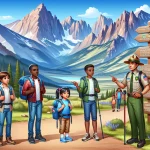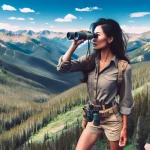Telluride’s Via Ferrata, also known as the “Krogerata” or “Kroger Via Ferrata,” offers a thrilling blend of hiking and climbing in the heart of Colorado’s San Juan Mountains. This unique route, spanning two miles of sheer cliffs and narrow ledges, attracts adventurers from around the world seeking to challenge themselves in a stunning alpine setting.
In This Article
TL;DR
- Via Ferrata Telluride is a significant addition to Colorado's outdoor adventure landscape, offering a unique blend of climbing and hiking experiences.
- The route requires technical climbing abilities and gear, and an accident could have serious consequences, making safety measures and proper preparation essential.
- The best time to attempt the Telluride Via Ferrata is from June through early October when weather conditions are favorable, and the winter snowpack has receded.
Understanding Via Ferrata
Via Ferrata, Italian for “iron road,” is a system of metal rungs, cables, and ladders fixed to a rock face, allowing climbers to navigate steep terrain with added safety. Originating in Europe during World War I to help troops traverse the Dolomite mountains, via ferratas have since evolved into a popular recreational activity, offering a taste of vertical adventure to those with limited climbing experience.
The Telluride Via Ferrata Experience
Telluride’s Via Ferrata route starts as a hiking trail near the base of Bridal Veil Falls, gradually narrowing to a ledge before disappearing altogether. Climbers must navigate exposed sections, steep drop-offs, and the infamous “Main Event” – a 300-foot stretch of metal ladder rungs traversing a sheer cliff face with a 200-foot drop below.
The route alternates between narrow trails and exposed ledges, with intermittent cable sections for added safety. To avoid crossing private property, climbers must return along the same path, making the full out-and-back journey a 3-4 hour commitment.
Preparation and Safety
Embarking on the Via Ferrata Telluride requires a good level of physical fitness, comfort with heights, and proper equipment. Essential gear includes:
- Sturdy, comfortable hiking shoes with good grip.
- Climbing harness, helmet, and via Ferrata lanyard with shock-absorbing capabilities.
- Weather-appropriate clothing, gloves, and a small backpack for water, snacks, and extra layers.
Climbers should assess their comfort level early on and be prepared to turn back if necessary. It’s crucial to stay clipped into the cable whenever possible and be mindful of loose rocks and other hazards.
Guided Tours vs. Independent Exploration
For those new to Via Ferrata or lacking proper equipment, guided tours offer a safer and more enjoyable experience. Reputable guide services like San Juan Mountain Guides, San Juan Outdoor Adventures, and Mountain Trip provide the necessary gear, expertise, and local knowledge.
Independent exploration is possible for experienced climbers with their own gear, but it’s essential to research the route, weather conditions, and safety protocols beforehand.
Impact on the Local Community and Environment
The Telluride Via Ferrata has become a popular attraction, benefiting the local economy through increased tourism and outdoor recreation. However, the route’s growing popularity has also raised concerns about environmental impact and sustainability.
The Telluride Mountain Club, in collaboration with local guide services, has established the Via Ferrata Sustainability Fund to help maintain and preserve the route for future generations. Visitors are encouraged to practice Leave No Trace principles and contribute to ongoing conservation efforts.
Planning Your Visit
Telluride offers a variety of accommodation options, from hotels and vacation rentals to camping and mountain huts. Visitors can combine their Via Ferrata experience with other outdoor activities like hiking, mountain biking, and rock climbing or explore the town’s vibrant cultural scene and historic landmarks.
When planning your visit, consider the seasonal weather patterns and book guided tours or secure permits in advance to ensure availability.
Beyond the Via Ferrata: Other Outdoor Adventures in Telluride
While the Via Ferrata is a standout attraction, Telluride boasts an array of outdoor adventures for all skill levels and interests:
- Hiking and backpacking in the surrounding San Juan Mountains.
- Rock climbing on nearby crags and peaks.
- Mountain biking on the area's extensive trail network.
- Exploring other Via Ferratas in the United States, such as those in Kentucky, West Virginia, and California.
FAQ
What is the best time of year to attempt the Telluride Via Ferrata?
The best time to climb the Telluride Via Ferrata is from June through early October when weather conditions are most favorable and the winter snowpack has melted.
Do I need any special equipment to participate in the Telluride Via Ferrata?
Yes, the essential equipment includes a climbing harness, helmet, sturdy hiking shoes, and a Via Ferrata lanyard with shock-absorbing capabilities.
Can beginners attempt the Telluride Via Ferrata, or is it only for experienced climbers?
While beginners can attempt the Telluride Via Ferrata, it is highly recommended to go with an experienced guide or climbing partner, as the route requires technical skills and can be mentally and physically challenging.
How do I find a reputable guide for the Telluride Via Ferrata?
Reputable guide services in the area include San Juan Mountain Guides, San Juan Outdoor Adventures, and Mountain Trip. Research and book in advance to ensure availability.
What are the safety measures in place for participants of the Telluride Via Ferrata?
Safety measures include the use of a Via Ferrata lanyard with shock-absorbing capabilities, helmets, and fixed cables and ladders along the route. Participants are encouraged to stay clipped in whenever possible and be mindful of potential hazards like loose rocks.






